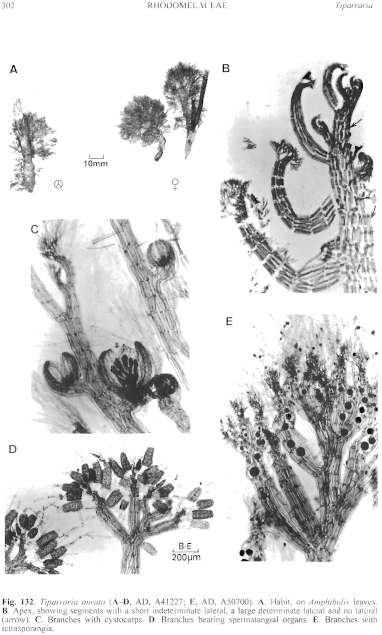|
|
|
|
|
|||||||||||
|
Electronic Flora of South Australia Species Fact Sheet
Phylum Rhodophyta – Family Rhodomelaceae – Tribe Herposiphonieae
Synonym
Polysiphonia aurata Harvey 1855a: 541; 1863, synop.: xxii.. J. Agardh 1863: 1026. De Toni 1903: 933. Lucas 1909: 41. Lucas & Perrin 1947: 275. Segi 1966: 505, pl. V B. Shepherd & Womersley 1981: 367. Sonder 1880: 35.
Thallus (Fig. 132A) orange-brown, (1–) 2–3 cm high, largely free from the host, with prostrate filaments bearing from successive segments a long, branched, indeterminate lateral, a short, slightly developed, branched lateral, and no lateral (Fig. 132B) on 1 (–3) segments, this sequence (with slight variation) then repeated on the next 3 segments. Erect indeterminate laterals becoming branched apically (especially when fertile), 5–10 (–20) mm long, branched usually from successive segments and each pair separated by 1–8 unbranched segments. Attachment by rhizoids; epiphytic on Posidonia and Amphibolis. Structure. Indeterminate apices upwardly recurved, apical cells hemispherical, 10–15 µm in diameter, segmenting transversely and subapical cells obliquely. Segments ecorticate, with (9–) 11–13 pericentral cells, 200–300 µm in diameter and L/D 0.7–1.2 in axes and 150–250 µm in diameter in lesser branches with L/D 1–1.5. Branches of erect indeterminate laterals bearing prominent trichoblasts, much branched, 1–2 mm long, basal cells 80–100 (–110) µm in diameter, short when immature, L/D 2–5 when mature. Rhizoids cut off from pericentral cells, unicellular with digitate haptera (becoming multicellular with ends of haptera branches cut off as terminal cells). Cells multinucleate; rhodoplasts discoid, becoming chained in older cells.
Reproduction: Gametophytes dioecious. Procarps not observed. Carposporophytes with a basal fusion cell and short gonimoblast with clavate terminal carposporangia 30–45 µm in diameter. Cystocarps (Fig. 132C) short-stalked, ovoid, 350–750 µm in diameter; pericarp ostiolate, 2 cells thick, ecorticate, outer cells irregular, angular. Spermatangial organs (Fig. 132D) replace usually the second cell of trichoblasts, 70–110 µm in diameter and L/D 1.5–2, with a sterile basal cell and 2 to several sterile apical cells.
Tetrasporangia (Fig. 132E) in upper branches of indeterminate laterals, spirally arranged, single per segment, 60–100 µm in diameter, with 3 cover cells.
Type from King George Sound, W. Aust. (Harvey, Trav. Set. No. 307); lectotype in Herb. Harvey, TCD.
Selected specimens: Cliff Head, W. Aust., on Amphibolis antarctica, drift (Womersley, 18.ix.1979; AD, A51245). Eucla, W. Aust., on A. griffithii, drift (Womersley, 5.x.1979; AD, A50700). Elliston, S. Aust., on A. antarctica, 3 m deep (Shepherd, 20.x.1970; AD, A37533). Murray Point, Port Lincoln, S. Aust., on Posidonia australis, uppermost sublittoral (Womersley, 6.i.1976; AD, A46780). Tiparra Reef, S. Aust., on A. griffithii, 11 m deep (Shepherd, 31.x.1970; AD, A37645 and 13.xii.1971; AD, A41227). Dany Beach, Corny Point, S. Aust., on A. antarctica, drift (Womersley, 15.x.1989; AD, A59902). Middle River, Kangaroo I., S. Aust., on Amphibolis, drift (Womersley, 8.i.1946; AD, A3425). Muston, Kangaroo I., S. Aust., on Posidonia australis, 2–4 m deep (Womersley, 22.viii.1963; AD, A26885). Kingston, S. Aust., on A. antarctica, 6–7 m deep (R. Lewis, 28.xi.1972; AD, A42866). Bridport, Tas., on Amphibolis, drift (Womersley & Parsons, 6.xi.1982; AD, A54555).
Distribution: Cliff Head, W. Aust., to Kingston, S. Aust., and N Tasmania.
References:
AGARDH, J.G. (1863). Species Genera et Ordines Algarum. Vol. 2, Part 3, pp. 787–1291. (Gleerup: Lund.)
DE TONI, G.B. (1903). Sylloge Algarum omnium hucusque Cognitarum. Vol. 4. Florideae. Sect. 3. pp. 775–1521 + 1523–1525. (Padua.)
HARVEY, W.H. (1855a). Some account of the marine botany of the colony of Western Australia. Trans. R. Jr. Acad. 22, 525–566.
HARVEY, W.H. (1863). Phycologia Australica. Vol. 5, Plates 241–300, synop., pp. i-lxxiii. (Reeve: London.)
LUCAS, A.H.S. & PERRIN, F. (1947). The Seaweeds of South Australia. Part 2. The Red Seaweeds. (Govt Printer: Adelaide.)
LUCAS, A.H.S. (1909). Revised list of the Fucoideae and Florideae of Australia. Proc. Linn. Soc. N.S.W. 34, 9–60.
SEGI, T. (1966). The type or authentic specimens of Polysiphonia in Europe. Rep. Fac. Fish., Prefect. Univ. Mie 5, 503–516, Plates 1–25.
SHEPHERD, S.A. & WOMERSLEY, H.B.S. (1981). The algal and seagrass ecology of Waterloo Bay, South Australia. Aquat. Bot. 11, 305–371.
SONDER, O.W. (1880). In Mueller, F., Fragmenta Phytographiae Australiae. Supplementum ad volumen undecinum: Algae Australianae hactenus cognitae, pp. 1–42, 105–107. (Melbourne.)
The Marine Benthic Flora of Southern Australia Part IIID complete list of references.
Publication:
Womersley, H.B.S. (24 February, 2003)
The Marine Benthic Flora of Southern Australia
Rhodophyta. Part IIID. Ceramiales – Delesseriaceae, Sarcomeniaceae, Rhodomelaceae
Reproduced with permission from The Marine Benthic Flora of Southern Australia Part IIID 2003, by H.B.S. Womersley. Australian Biological Resources Study, Canberra. Copyright Commonwealth of Australia.
Illustration in Womersley Part IIIA, 2003: FIG. 132.

Figure 132 enlarge
Fig. 132. Tiparraria aurata (A–D, AD, A41227; E, AD, A50700). A. Habit, on Amphibolis leaves. B. Apex, showing segments with a short indeterminate lateral, a large determinate lateral and no lateral (arrow). C. Branches with cystocarps. D. Branches bearing spermatangial organs. E. Branches with tetrasporangia.

|
Email Contact: State Herbarium of South Australia |

|